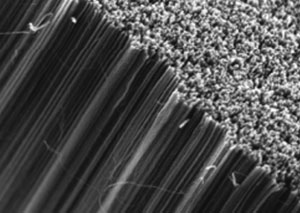 3D carbon nanotube forests are of particular interest in the electrochemical arenas of sensing and energy applications. Some researchers have suggested that it is necessary to use open-ended carbon nanotubes and carry out a pre-treatment or activation step to support fast electrochemistry, but is this always the case?
3D carbon nanotube forests are of particular interest in the electrochemical arenas of sensing and energy applications. Some researchers have suggested that it is necessary to use open-ended carbon nanotubes and carry out a pre-treatment or activation step to support fast electrochemistry, but is this always the case?
Patrick Unwin and co-workers set out to investigate. They prepared carbon nanotube forests using a chemical vapour deposition growth method. To probe the local electrochemical response of the forests, they used a nanoscopic double barrelled pipette tip, filled with supporting electrolyte and redox species. This allowed the team to interrogate the sidewalls and closed ends of the nanotubes that made up the forest with high spatial resolution.
Both sidewalls and the closed tube ends were capable of fast electron transfer proving that single walled carbon nanotubes do not require open ends for fast electrochemistry with outer sphere redox couples. This overturns the current consensus, based on averaged macro-sized measurements, that open ends dominate nanotube forest electrochemistry.
Without the requirement for pre-treatment or activation, electrochemical nanotube forest applications will be easier to achieve.
To find out more, download the ChemComm article today.










